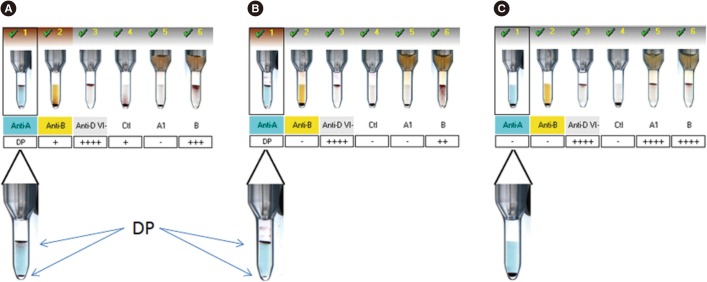Ann Lab Med.
2017 May;37(3):293-295. 10.3343/alm.2017.37.3.293.
A Puzzling “Switch†in Blood Type Following Blood Transfusion
- Affiliations
-
- 1Blood Bank and Molecular Hematology Laboratory, Galilee Medical Center, Nahariya, Israel. akrial@gmc.gov.il
- 2Pediatric Intensive Care Unit, Galilee Medical Center, Nahariya, Israel.
- 3Cytogenetic Laboratory, Galilee Medical Center, Nahariya, Israel.
- 4Department of Surgery, Galilee Medical Center, Nahariya, Israel.
- 5Department of Hematology, Galilee Medical Center, Nahariya, Israel.
- 6Department of Pediatrics, Galilee Medical Center, Nahariya, Israel.
- 7Faculty of Medicine in the Galilee, Bar Ilan University, Safed, Israel.
- KMID: 2369760
- DOI: http://doi.org/10.3343/alm.2017.37.3.293
Abstract
- No abstract available.
MeSH Terms
Figure
Reference
-
1. Oetting WS, Lee HK, Flanders DJ, Wiesner GL, Sellers TA, King RA. Linkage analysis with multiplexed short tandem repeat polymorphisms using infrared fluorescence and M13 tailed primers. Genomics. 1995; 30:450–458. PMID: 8825630.2. Zivony-Elboum Y, Westbroek W, Kfir N, Savitzki D, Shoval Y, Bloom A, et al. A founder mutation in Vps37A causes autosomal recessive complex hereditary spastic paraparesis. J Med Genet. 2012; 49:462–472. PMID: 22717650.3. Utter GH, Nathens AB, Lee TH, Reed WF, Owings JT, Nester TA, et al. Leukoreduction of blood transfusions does not diminish transfusion-associated microchimerism in trauma patients. Transfusion. 2006; 46:1863–1869. PMID: 17076839.4. Utter GH. The microchimerism puzzle. Transfusion. 2012; 52:926–928. PMID: 22571359.
- Full Text Links
- Actions
-
Cited
- CITED
-
- Close
- Share
- Similar articles
-
- Experience in Establishing Department of Transfusion Management
- A Transfusion Experience for a Patient with Cis-A2B3 Phenotype
- Anesthetic Experience of Hemorrhagic Shock Patient with Rh-, AB Blood Type without Blood Transfusion
- Managerial Strategy for the Transportation and Transfusion Period for the Blood Components at Hospitals: An Opinion
- Recent changing patterns of blood transfusion practice in Ewha womans university hospital during 10 years



